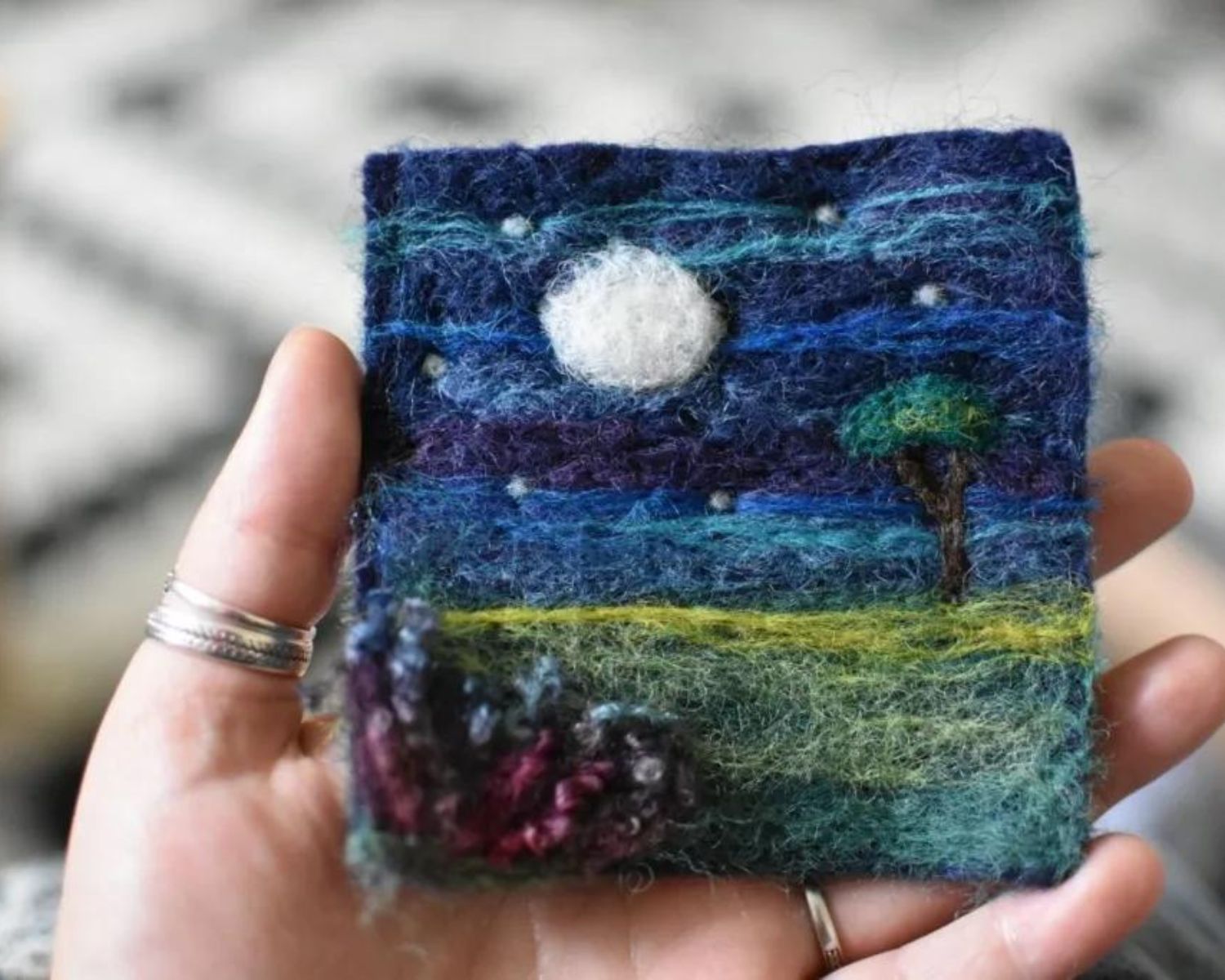
Felting is a fascinating craft that has been around for centuries. It involves manipulating fibers, such as wool, to create fabric-like pieces without the need for weaving or knitting. Two common techniques used in felting are wet felting and needle felting. Wet felting involves agitating and matting the fibers together using water and soap, while needle felting involves using a special needle to interlock the fibers. Whether you are a seasoned felting enthusiast or just curious about this unique craft, you’ll be amazed by these 18 intriguing facts about felting. From its ancient origins to its modern-day applications, felting continues to captivate artists and crafters alike. So, let’s dive into the colorful and fascinating world of felting!
Key Takeaways:
- Felting is a versatile and sustainable craft that dates back thousands of years, offering endless possibilities for creativity and self-expression. It’s a therapeutic and relaxing activity that can be enjoyed by beginners and experienced artists alike.
- Whether you’re creating seamless garments with wet felting or intricate sculptures with needle felting, the world of felting is full of intriguing facts and opportunities for artistic exploration. So grab some wool and let your imagination take flight!
The art of felting dates back thousands of years.
Felting is a technique that has been practiced for centuries, with evidence of its use dating back to the Bronze Age. It is believed to have originated in Central Asia and has since spread across various cultures and regions.
Wet felting is the oldest form of felting.
Wet felting involves using hot water, soap, and agitation to mesh fibers together and create a solid fabric. It is used to make items like blankets, rugs, and clothing.
Needle felting is a more recent technique.
Unlike wet felting, needle felting uses a barbed needle to interlock fibers. This technique allows for more detailed and intricate designs and is often used to create sculptures, ornaments, and other decorative items.
Felting can be done with various types of fibers.
Felting can be achieved with animal fibers such as wool, alpaca, and cashmere, as well as with plant-based fibers like bamboo and hemp. Each type of fiber has its own unique properties and qualities when felted.
Wet felting is often used to create seamless items.
Due to the meshing together of fibers, wet felting allows for the creation of seamless garments and accessories, eliminating the need for sewing.
Needle felting allows for intricate surface designs.
The barbed needle used in needle felting allows artists to add details, patterns, and even textures to their creations, making it a versatile technique for creating unique and personalized art pieces.
Felting can transform wool roving into sturdy fabrics.
By applying pressure, heat, and moisture, the loose wool fibers in roving can be transformed into dense and durable fabrics through the process of felting.
Felted items are known for their insulation properties.
Felting creates air pockets within the fabric, which enhances its insulation properties. This makes felted items perfect for keeping warm in colder climates.
Felting is a sustainable crafting technique.
The use of natural fibers and the ability to repurpose old clothing and materials make felting an environmentally-friendly crafting option.
Felting can be used to create three-dimensional sculptures.
Using the needle felting technique, artists can create intricate and lifelike sculptures of animals, people, and objects, displaying their creativity and skill.
Felted items are durable and long-lasting.
The compact and meshed structure of felted fibers makes them resistant to wear and tear, ensuring that felted items can withstand years of use.
Felting can be a therapeutic and relaxing activity.
The repetitive motion and focus required in felting can have a calming effect on the mind, making it a popular craft for stress relief and mindfulness.
Felting can be combined with other crafting techniques.
Artists often incorporate felting with other techniques such as embroidery, beadwork, and weaving to create unique mixed-media pieces.
Felting can be used to create accessories like hats and bags.
The versatility of felting allows for the creation of functional and fashionable accessories that can be customized to suit individual style and preferences.
Various cultures have their own traditional felting techniques.
Felting has been adapted and developed differently across the world, with techniques like Nuno felting from Japan and Rug hooking from North America.
Felting is a popular craft for both beginners and experienced artists.
Whether you are just starting your felting journey or have been felting for years, there is always something new to explore and create with this versatile craft.
Felting workshops and classes are available worldwide.
If you are interested in learning more about felting or improving your felting skills, there are numerous workshops and classes conducted by experienced artists and instructors to help you enhance your craft.
Felting is a form of self-expression and creativity.
Through felting, artists can bring their imagination to life, creating unique and expressive pieces that showcase their artistic vision and style.
Conclusion
In conclusion, felting is a fascinating craft that offers a wide range of creative possibilities. Whether you’re exploring the art of wet felting or experimenting with needle felting, the process of intertwining fibers to create unique and textured designs can be both therapeutic and rewarding. From its origins dating back thousands of years to its modern adaptations, felting has evolved into a popular technique embraced by artists and hobbyists worldwide.With wet felting, you can create seamless pieces such as hats, scarves, and even three-dimensional sculptures. Needle felting, on the other hand, allows for more intricate details and precise shaping. The versatility of felting techniques enables artists to explore various textures, colors, and patterns, resulting in stunning and innovative creations.So, whether you’re a beginner venturing into the world of felting or an experienced crafter looking to expand your skills, the art of felting is sure to captivate your imagination and bring your creative visions to life.
FAQs
1. What is wet felting?
Wet felting is a process where layers of wool fibers are agitated with hot water, soap, and pressure to interlock and bond together, creating a dense fabric.
2. What is needle felting?
Needle felting is a technique where a barbed needle is repeatedly stabbed into wool fibers, entangling them and creating a desired shape or design.
3. Do I need any special tools for felting?
For wet felting, you will need wool fibers, hot water, soap, and a surface for felting. Needle felting requires special felting needles and a foam pad to protect your work surface.
4. Can I mix different types of fibers when felting?
Yes, you can mix different types of fibers, such as wool, silk, alpaca, or synthetics, to create unique textures and effects in your felting projects.
5. Is felting only limited to clothing and accessories?
No, felting can be used to create a wide range of objects, including decorative items, toys, wall hangings, and even jewelry.
6. Is felting a time-consuming process?
The time required for felting projects can vary depending on their size and complexity. Simple projects can be completed in a few hours, while more intricate pieces may take several days or even weeks.
7. Can felting be done by children?
Felting can be a fun and engaging activity for children; however, adult supervision is recommended, especially when using sharp felting needles.
8. Can I wash and care for felted items?
Felted items can be hand washed using mild detergent and lukewarm water. It’s important to avoid excessive agitation or temperature changes to prevent shrinking or warping of the fabric.
9. Can I incorporate other techniques with felting?
Absolutely! Felting can be combined with techniques like embroidery, beading, or mixed media to add even more dimension and interest to your projects.
10. Where can I find felting supplies?
Felting supplies, including fibers, needles, and tools, can be found at craft stores, online shops, or specialty fiber shops that cater to fiber artists.
Was this page helpful?
Our commitment to delivering trustworthy and engaging content is at the heart of what we do. Each fact on our site is contributed by real users like you, bringing a wealth of diverse insights and information. To ensure the highest standards of accuracy and reliability, our dedicated editors meticulously review each submission. This process guarantees that the facts we share are not only fascinating but also credible. Trust in our commitment to quality and authenticity as you explore and learn with us.


